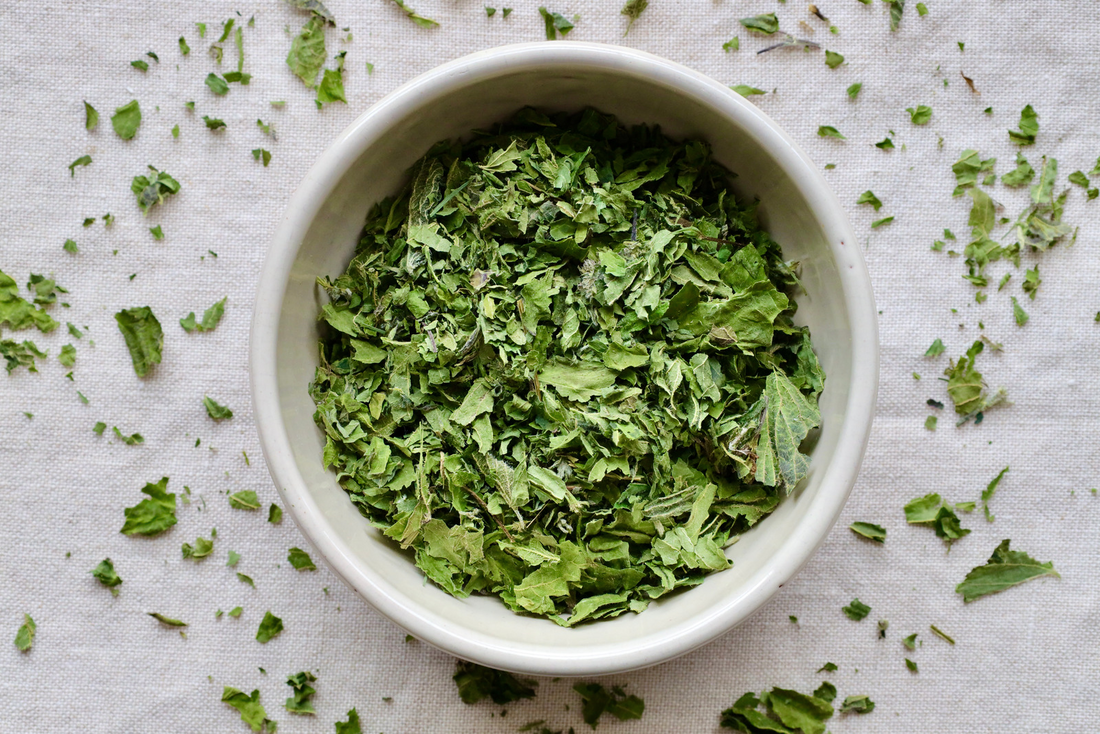
Health Benefits of Stinging Nettle
If you're new to the world of herbs, the name stinging nettle might sound more like something to steer clear of than something to sip in your tea. But don’t be fooled by its sting—this humble plant has earned a place in herbal traditions around the world and is quietly making its way into more kitchens, apothecaries, and gardens each year.
At La Ferme À Ciel Sur Mer, we’ve come to deeply appreciate the gifts of nettle, and we’re lucky to grow it in one of the most pristine corners of Quebec.
Why Nettles? The Nutritional and Herbal Benefits
Nettle (Urtica dioica) is one of those herbs that truly lives up to the term "nutrient-dense." Rich in iron, calcium, magnesium, vitamin C, and protein, nettle is often used to support energy, nourish the blood, and strengthen the body's foundational systems. In herbalism, it’s considered a tonic—something that can be taken regularly to build long-term wellness.
You’ll find nettle used in a variety of ways: as a gentle daily tea, in nourishing infusions, powdered into green blends, or even added to soups and stews. It’s especially loved by herbalists for its support in times of fatigue, low iron, seasonal allergies, or recovery.
And while you can find nettle products on health food store shelves, there’s something special about knowing the land your herbs come from—and the people who grow them.

A Natural Fit for Charlevoix
Our farm sits in Charlevoix, a region known for its rugged coastlines, mountain views, and clean air. These conditions create a near-perfect environment for growing herbs like nettle. The wildness of this place—the cold spring water, the mineral-rich soil, the bracing winds—seems to resonate in the plants themselves.
Nettle thrives here, even in a short growing season. Once it’s established, it comes back year after year, offering early spring greens followed by deep, vibrant summer growth. We harvest nettle by hand, with care (and gloves!), and dry it slowly to preserve its vibrant green color and full spectrum of constituents.
What’s It Like to Grow Nettles?
If you’ve ever brushed up against a nettle patch, you’ll understand one of the biggest challenges: the sting. Nettles are covered in tiny hairs that release formic acid when touched, which can cause a temporary rash or tingling sensation. It’s one of the plant’s natural defense systems—and one reason most people learn to respect it very quickly.
On the farm, this means harvesting with intention and attention. We cut just before flowering, when the plant is at its peak. The work requires patience and care, but for us, nettle is worth the effort. It’s one of the first plants to feed the soil and one of the best to nourish us in return.

How to Use Nettle
There are so many ways to enjoy nettle:
-
Nettle tea
-
A simple steep of dried nettle leaf offers a mineral-rich, grassy infusion.
-
Fresh nettle
-
Blanched or cooked, nettle loses its sting and can be used much like spinach.
-
Nettle tincture
-
A potent way to support the body, especially during allergy season.
-
Bulk dried nettle
-
Great for tea, culinary use, or herbal preparations.
At our farm, we offer dried nettle leaves and nettle tea blends seasonally, and occasionally fresh nettle by request. We also love helping people learn how to work with this plant themselves—whether it’s drying your own harvest or making simple remedies like nettle vinegar or oxymel.
Sourcing Nettle Sustainably
One of the beautiful things about nettle is how low-impact it is to grow. Once established, nettle doesn’t require tilling or heavy intervention. It improves the soil, supports pollinators, and even helps restore disturbed land. For us, it’s part of a broader vision of regenerative farming—where plants, people, and place all support one another.
By sourcing nettle from small farms like ours, you're not only getting a high-quality herb, you're also investing in a slower, more intentional way of growing and harvesting. It's a way to connect your wellness practices to the rhythms of the land.
Looking for Nettle Products?
Whether you're searching for dried nettle, tea blends, or curious about growing your own, there are more ways than ever to bring this vibrant herb into your life. If you’d like to explore what we offer at La Ferme À Ciel Sur Mer, we welcome you to visit our online shop, reach out with questions, or come say hello if you’re ever in Charlevoix.
Nettle might just surprise you—with its sting (ha!), with its strength, and with its capacity to nourish from the ground up.
Frequently Asked Questions
What are the benefits of drinking nettle tea?
Nettle tea is rich in minerals like iron, calcium, and magnesium. It’s commonly used to support energy levels, ease seasonal allergies, and nourish the body over time. Many herbalists consider it a daily tonic for building long-term vitality.
Can you eat fresh nettle leaves?
Yes—once lightly cooked or blanched, fresh nettle loses its sting and becomes safe to eat. It’s similar to spinach in texture and flavor, and is excellent in soups, pestos, and sautés. Always handle raw nettle with gloves to avoid irritation.
Related:

Interested in knowing more about what's going on on the farm? Our occasional emails bring you stories from the field, new herbs for sale, and herbal insights.
🌱 Browse our organic herbs or Sign up for our newsletter to stay connected.